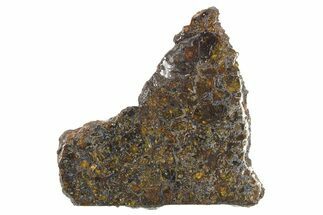This Specimen has been sold.
1.3" Brenham Pallasite "Dog Tag" Meteorite Pendant - Kansas
This is a 1.3" tall Brenham pallasite meteorite pendant. The meteorite slice is covered by a clear epoxy resin and has been set in a "dog tag" shaped, 925 silver frame. It is accompanied by snake chain necklace.
The Brenham Pallasite
The Brenham pallasite meteorite was discovered in 1882 in association with a 50-foot impact crater near Brenham, Kansas. This impact crater is estimated to be 1,000 years old and is one of the smallest known impact craters on the planet. Since the initial discovery, many pallasite masses from the Brenham fall have been recovered from the surrounding area. About four to eight tons of material have been recovered over the years, including a single, 1,430-pound specimen, the largest pallasite meteorite fragment found in North America.
Parts of the Brenham meteorite are filled with beautiful, yellow-green peridot crystals, while large areas are devoid of these space gems. Long before the first Brenham meteorites were found by farmers, they were used as a source of iron by local Indigenous tribes. Pieces of iron derived from this meteorite fall have been found at archeological sites across much of the eastern US.
The Brenham pallasite meteorite was discovered in 1882 in association with a 50-foot impact crater near Brenham, Kansas. This impact crater is estimated to be 1,000 years old and is one of the smallest known impact craters on the planet. Since the initial discovery, many pallasite masses from the Brenham fall have been recovered from the surrounding area. About four to eight tons of material have been recovered over the years, including a single, 1,430-pound specimen, the largest pallasite meteorite fragment found in North America.
Parts of the Brenham meteorite are filled with beautiful, yellow-green peridot crystals, while large areas are devoid of these space gems. Long before the first Brenham meteorites were found by farmers, they were used as a source of iron by local Indigenous tribes. Pieces of iron derived from this meteorite fall have been found at archeological sites across much of the eastern US.
About Pallasites
Pallasite meteorites are a class of stony-iron meteorites. They were once believed to have originated at the core-mantle boundary of asteroids that shattered through impacts, but a recent hypothesis is that they are a mixture of core and mantle minerals.
Pallasite meteorites consist of olivine (peridot) crystals surrounded by iron-nickel matrix. Upon acid etching, some pallasites display interweaving structures known as Widmanstätten patterns (or Thomson lines) in the metallic matrix. These structures are iron-nickel alloy crystals, typically kamacite and taenite, that cooled over millions of years in the vacuum of space.
Pallasites are quite rare: only about 200 are known, and only four have had observed falls. This represents less than 0.2% of all classified meteorites!
Pallasite Care
Pallasites are even more susceptible than most iron meteorites to rusting and deterioration due to moisture in the atmosphere; proper care includes keeping them in moisture-free environments. This is particularly important in areas with high humidity, such as Florida. All pallasite material we sell has been stabilized in some way, which will help with this issue, but care still needs to be taken to keep your treasure in good condition. Keep pallasites stored in a moisture-free environment, preferably with a corrosion inhibitor such as silica gel beads or a dehumidifier.
Pallasite meteorites are a class of stony-iron meteorites. They were once believed to have originated at the core-mantle boundary of asteroids that shattered through impacts, but a recent hypothesis is that they are a mixture of core and mantle minerals.
Pallasite meteorites consist of olivine (peridot) crystals surrounded by iron-nickel matrix. Upon acid etching, some pallasites display interweaving structures known as Widmanstätten patterns (or Thomson lines) in the metallic matrix. These structures are iron-nickel alloy crystals, typically kamacite and taenite, that cooled over millions of years in the vacuum of space.
Pallasites are quite rare: only about 200 are known, and only four have had observed falls. This represents less than 0.2% of all classified meteorites!
Pallasite Care
Pallasites are even more susceptible than most iron meteorites to rusting and deterioration due to moisture in the atmosphere; proper care includes keeping them in moisture-free environments. This is particularly important in areas with high humidity, such as Florida. All pallasite material we sell has been stabilized in some way, which will help with this issue, but care still needs to be taken to keep your treasure in good condition. Keep pallasites stored in a moisture-free environment, preferably with a corrosion inhibitor such as silica gel beads or a dehumidifier.
TYPE
Pallasite (PMG-an)
LOCATION
Brenham, Kiowa County, Kansas
SIZE
Pendant 1.35 x .85"
CATEGORY
SUB CATEGORY
ITEM
#309157
 Reviews
Reviews












